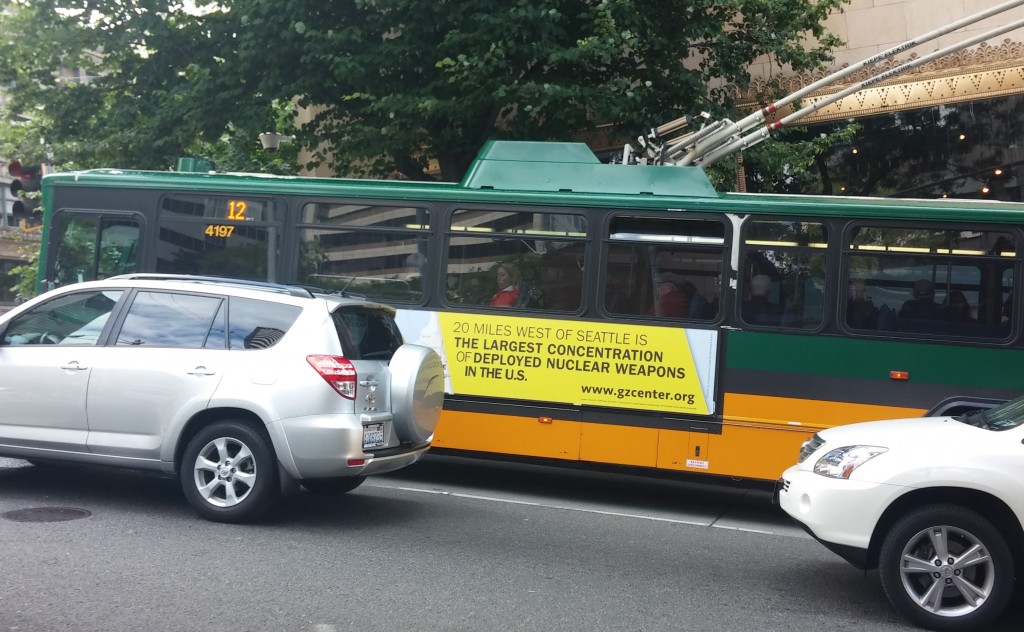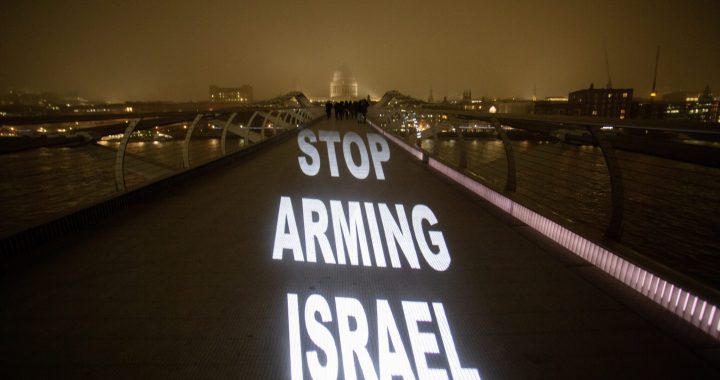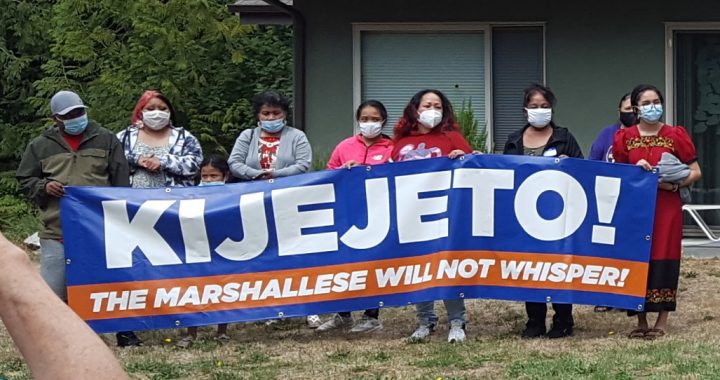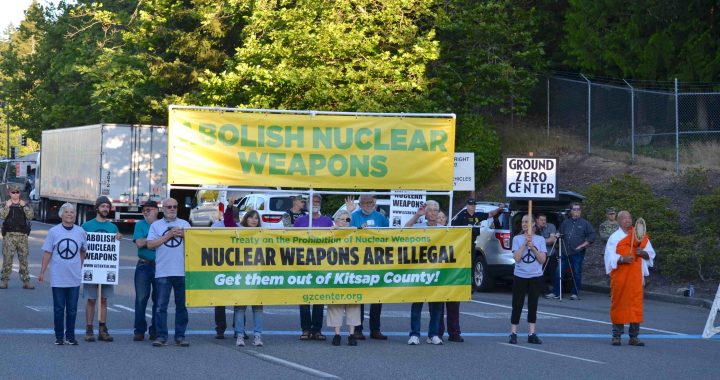Earlier this week, and continuing for eight weeks, 14 King County Metro Transit buses began displaying the following controversial paid advertisement: 20 MILES WEST OF SEATTLE IS THE LARGEST CONCENTRATION OF DEPLOYED NUCLEAR WEAPONS IN THE US. Included in the advertisement is a map showing the proximity of Seattle to Naval Base Kitsap Bangor, home port for 8 of the Navy’s 14 Trident nuclear powered ballistic missile submarines.
The statement in the ad refers to the combined number of nuclear warheads deployed on Trident D-5 missiles on SSBN submarines based at Bangor and nuclear warheads stored at Strategic Weapons Facility Pacific (SWFPAC). Approximately 1,300 nuclear warheads are deployed 20 miles west of Seattle at the Bangor submarine base.
King County Metro was initially hesitant to run the ad, and questioned the accuracy of the statement of fact regarding the number of nuclear weapons at Bangor. Ground Zero contacted Hans Kristensen, director of the Nuclear Information Project at the Federation of American Scientists, who provided corroboration of its statement. Kristensen provides the public and government agencies with analysis and background information about the status of nuclear forces worldwide and the geopolitical implications of nuclear weapons. See cited source material here. Click here to read Kristensen’s most recent article on the new weapons facility at Bangor.
The bus ads are an effort by Ground Zero Center for Nonviolent Action, a grass roots organization in Poulsbo, Washington, to reawaken public awareness of the dangers of nuclear weapons.
Ground Zero member, Rodney Brunelle, said of the bus ad campaign, “We hope to generate a measure of citizen interest, and to begin a public discussion of nuclear weapons in the Puget Sound region. In this election year the danger of nuclear weapons ought to be a topic of discussion.”
On March 11, 2016, the 10th bi-annual Nuclear Deterrent Symposium was held in Silverdale to discuss the future of U.S. strategic forces. Rear Adm. Charles Richard criticized opposition to the Navy’s $100 billion plan for 12 new replacement SSBN submarines, proclaiming, “It’s a matter of priorities.” The new SSBNs would replace the submarines at Bangor. Rear Adm. Richards noted that the USS Ohio arrived at Bangor in 1981 to much protest, and stated, “We have taken that [nuclear weapons] out of the national psyche.”
The Trident Fleet is part of the US nuclear triad – submarines, land-based missiles, and bombers – that the government refers to as its “strategic nuclear deterrent.Watch movie online The Transporter Refueled (2015)
The U.S. Navy’s current planning for a new fleet of ballistic missile submarines, costing nearly $100 billion to build, is accelerating the rapidly developing submarine nuclear arms race. It has been estimated that by the time the new generation of ballistic missile submarines is put into service, it will represent 70 percent of the nation’s deployed nuclear warheads.
In addition to to building a $448 million Second Explosives Handling Wharf at Bangor, the Navy has quietly constructed a new $294 million underground nuclear weapons storage complex at the Strategic Weapons Facility Pacific (SWFPAC), the high-security base at Bangor that stores and maintains the Trident II ballistic missiles and their nuclear warheads for deployment on the Trident submarines. Hans Kristensen has just published a revealing article on the new facility: Navy Builds Underground Nuclear Weapons Storage Facility; Seattle Busses Carry Warning.
Ground Zero’s NO To NEW TRIDENT Campaign (notnt.org) is working to de-fund the Navy’s plans for the next generation of ballistic missile submarines that it considers dangerous and destabilizing. The nuclear armed nations, led by the U.S., need to be making sincere efforts to work toward nuclear disarmament.
The issues
* The U.S. is currently spending more on nuclear weapons programs than during the height of the Cold War.
* The U.S. currently plans to spend an estimated $1 trillion dollars over 30 years for rebuilding the nation’s nuclear facilities and modernizing nuclear weapons.
* The New York Times reported that the U. S., Russia and China are aggressively pursuing a new generation of smaller and less destructive nuclear weapons. The buildups threaten to revive a Cold War-era arms race and unsettle the balance of power among nations.
* The U.S. Navy states that SSBN submarines on patrol provide the U.S. with its “most survivable and enduring nuclear strike capability.” However, SSBNs in port and nuclear warheads stored at SWFPAC are likely a first target in a nuclear war. The latest Google imagery shows three SSBN submarines on the Hood Canal waterfront.
* An accident involving nuclear weapons occurred on November 2003 when a ladder penetrated a nuclear nosecone during a routine missile offloading at the Explosives Handling Wharf at Bangor. All missile-handling operations at SWFPAC were stopped for nine weeks until Bangor could be recertified for handling nuclear weapons. Three top commanders were fired but the public was never informed until information was leaked to the media in March 2004.
* Public responses from governmental officials to the 2003 missile accident were generally in the form of surprise and disappointment.
* Due to ongoing modernization and maintenance programs for warheads at Bangor, nuclear warheads are routinely shipped in unmarked trucks between the Department of Energy Pantex Plant near Amarillo, Texas and the Bangor base. Unlike the Navy at Bangor, the DOE actively promotes emergency preparedness.
* Ground Zero Center for Nonviolent Action and Washington Physicians for Social Responsibility are involved in an environmental lawsuit against the Navy’s second Explosives Handling Wharf at Bangor. As a result of the lawsuit, plaintiffs discovered that while the Navy insisted the second wharf posed no new safety risk at the base, the federal agency responsible for explosives siting refused to grant approval. The case was filed in federal court in June 2012 and is currently pending in the 9th Circuit Court of Appeals.
* On December 14, 2015, the Navy filed a lawsuit in federal court to block the release of emergency response plans that might benefit the public in the case of a nuclear accident at Bangor. The lawsuit is still pending.
The bus ad
The bus ads measure 30 inches tall and 144 inches in length and are posted on the sides of 14 Metro buses in downtown Seattle. An interactive map of the bus routes may be viewed at http://mapping.titan360.com/atlas.aspx?mapId=33301 The blue lines show routes that are scheduled for buses with the ads and the black lines show routes of buses that may carry the ads.

King County Metro Transit bus on June 21st at 2nd and Madison in downtown Seattle. (Photo credit: Mira Leslie )
Nuclear weapons and resistance
In the 1970s and 1980s, thousands demonstrated against nuclear weapons at the Bangor base and hundreds were arrested. Seattle Archbishop Hunthausen publicly denounced what he referred to as the idolatry of nuclear deterrence, and proclaimed the Bangor submarine base the “Auschwitz of Puget Sound.” He called for massive citizen tax resistance, and in 1982 began to withhold half of his federal taxes.
One Trident SSBN submarine at Bangor is estimated to carry about 108 nuclear warheads. The W76 and W88 warheads at Bangor are equal respectively to 100 kilotons and 455 kilotons of TNT in destructive force. One submarine deployed at Bangor is equal to about 1,400 Hiroshima sized nuclear bombs.
On May 27, 2016, President Obama spoke in Hiroshima and called for an end to nuclear weapons. He said that the nuclear powers “…must have the courage to escape the logic of fear, and pursue a world without them.” Obama added, “We must change our mindset about war itself.”
This summer the historic sailing vessel the Golden Rule is visiting many ports in the Pacific Northwest. Veterans For Peace is using the Golden Rule to advance its opposition to nuclear weapons and war. Currently the vessel is under the command of retired Navy captain and former nuclear submarine commander Tom Rogers.
___________________________________________________
The Ground Zero Center for Nonviolent Action was founded in 1977. The center is on 3.8 acres adjoining the Trident submarine base at Bangor, Washington. The Ground Zero Center for Nonviolent Action offers the opportunity to explore the roots of violence and injustice in our world and to experience the transforming power of love through nonviolent direct action. We resist all nuclear weapons, especially the Trident ballistic missile system.
Upcoming Ground Zero events:Watch Ungodly Acts (2015) Full Movie Online Streaming Online and Download
* Numerous activities with the historic peace vessel, the Golden Rule and Veterans for Peace throughout the summer. Our first event with the Golden Rule will be in Poulsbo on June 28. Click here for the full Pacific Northwest event schedule.
* The annual Interfaith Peace Walk led by Bainbridge Island Nipponzan Myohoji Buddhist Temple takes place from July 24 to August 9, 2016.
* Ground Zero Peace Fleet with the Golden Rule in Elliott Bay on August 3.
* From Hiroshima to Hope event at Green Lake on August 6 commemorating the victims of the Hiroshima bombing 71 years ago.
* The Annual Ground Zero Hiroshima/Nagasaki Commemoration takes place August 7 and 8 at Ground Zero Center for Nonviolent Action with a vigil and nonviolent civil resistance at entrance to Bangor.
* Boats by Bangor on August 9, will be a flotilla of small boats, the Golden Rule and other sail boats in the waters of Hood Canal out past the perimeter of Naval Base Kitsap Bangor.
More information on all these events is at the Ground Zero Center Upcoming Events calendar.
PRESS INQUIRIES
For further information or interviews, please contact one of the following:
Leonard Eiger (425) 445-2190
Glen Milner (206) 365-7865
Rodney Brunelle (425) 485-7030
Hans Kristensen, (Federation of American Scientists and expert source cited in
bus ad) (202) 454-4695




